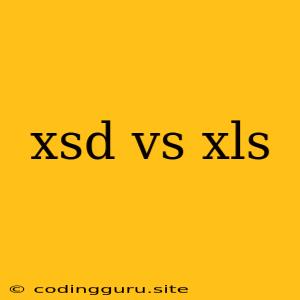What is the difference between XSD and XLS?
XSD and XLS are both widely used file formats, but they serve completely different purposes. XSD stands for XML Schema Definition, while XLS stands for Excel Spreadsheet. Understanding their distinct roles is crucial for choosing the right format for your data.
XSD: Defining the Structure of XML Data
XSD files are used to define the structure and rules for XML (Extensible Markup Language) documents. Imagine XSD as a blueprint for your XML data, outlining the elements, attributes, and data types allowed within the document. This provides a standardized way to validate and process XML data, ensuring consistency and accuracy.
Think of it this way:
- XSD is the grammar for your XML language.
- XML is the sentence written according to that grammar.
XLS: Storing and Organizing Data in Spreadsheets
XLS files are essentially spreadsheets created using Microsoft Excel. They provide a structured way to store and manage data in rows and columns, allowing you to perform calculations, create charts, and analyze data effectively. XLS files are widely used in various fields, including business, finance, and data analysis.
Key Differences between XSD and XLS:
| Feature | XSD | XLS |
|---|---|---|
| Purpose | Define structure of XML data | Store and organize data in spreadsheets |
| Content | XML schema definitions | Spreadsheet data (text, numbers, formulas) |
| File Extension | .xsd | .xls |
| Data Format | Text-based | Spreadsheet-based |
| Applications | XML validation, data exchange | Data analysis, reporting, calculations |
When to Use XSD and XLS
Here's a simple guideline:
- Use XSD: When you need to define the structure and rules for XML data, ensuring consistency and validation.
- Use XLS: When you need to organize and analyze data in a spreadsheet format, perform calculations, and create charts.
Example Scenario
Imagine you are developing a website that needs to exchange product information with other websites. You can use XSD to define the structure of your product information in XML format, ensuring that all websites adhere to the same format. This will allow for seamless data exchange and prevent errors.
Example of an XSD file:
This XSD file defines the structure for a "product" element with attributes like "name", "price", and "description".
On the other hand, you can use XLS to store and analyze your sales data, generating charts and reports.
Example of an XLS file:
| Product | Price | Quantity |
|---|---|---|
| Apple | 1.00 | 10 |
| Banana | 0.50 | 20 |
| Orange | 0.75 | 15 |
This simple spreadsheet in XLS format allows you to easily track your sales data and analyze it further.
Conclusion
XSD and XLS are distinct file formats serving different purposes. XSD defines the structure of XML data, while XLS provides a spreadsheet format for storing and organizing data. Choose the appropriate format based on your specific data management and processing needs.
